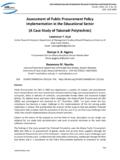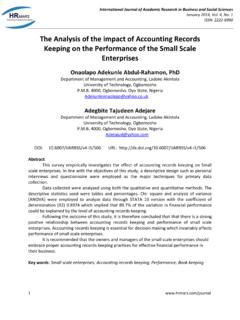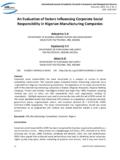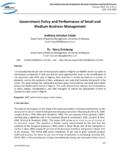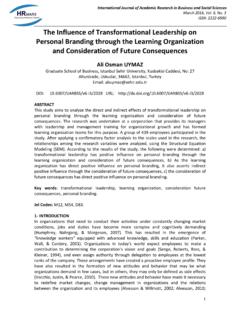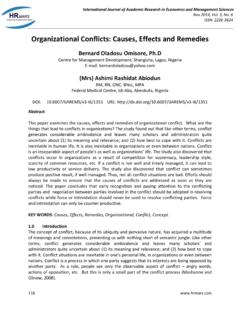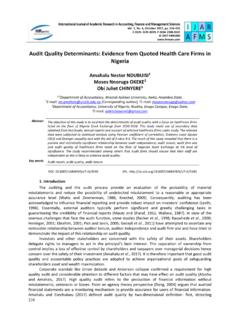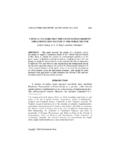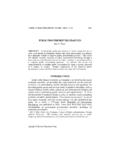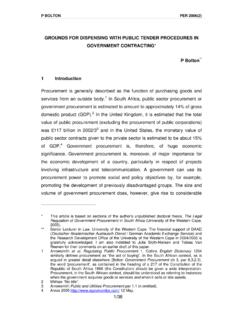Transcription of Factors affecting the Rate of Disposal of Assets in …
1 International journal of Academic Research in Business and Social Sciences May 2014, Vol. 4, No. 5 ISSN: 2222-6990 1 Factors affecting the Rate of Disposal of Assets in public Sector Organizations: A Case Study of Yatta Sub-County- Kenya Susan A. M. & Prof. Namusonge Jomo Kenyatta University of Agriculture and Technology, School of Human Resource Development, Department of Entrepreneurship and procurement , Box 62000-00200 Nairobi, Kenya Email: DOI: URL: Abstract Disposal of unwanted Assets is a critical element of stores and equipment management in any organization. When, for example, equipment is obsolete, continuing to keep it through maintenance, storage, parking, insurance, etc. may well exceed the returns that can be derived from the use of that equipment.
2 public entities in Kenya have specific Disposal procedures and guidelines as provided for in the public procurement and Disposal Act, 2005 and public procurement and Disposal Regulations, 2006. This research project was a case study that sought to assess the Factors affecting the rate of Disposal of Assets by the public sector organizations within Yatta Sub-County. A census was carried out on all the 28 Government Departments whereby 60 employees who were considered to have relevant information to the study were taken as the respondents. Questionnaires, interview guide and observation schedule were used to collect data. The study attained a 100% response rate. The findings of the study were that overall; the rate of Disposal in public sector organizations in Yatta sub-county was low and that the process of procurement planning for Disposal was reported as long and tedious.
3 Key words: The rate of asset Disposal Introduction Asset Disposal is mostly known as the act of selling an asset usually a long term asset that has been depreciated over its useful life like production plant and vehicles (Baily et al, 1998). Disposal may be considered as the third life of any item acquired by a procuring entity; first it is procured and accepted- the procurement cycle; second it is utilized by the procuring entity in the discharge of its duties-the life cycle; third it has to be disposed- the Disposal cycle ( public procurement Oversight Authority, 2009). The user department should have the responsibility of identifying items to be disposed and where possible assemble them together. The head of stores should be responsible for identification of stocked items which are candidates for Disposal and the lists of all items identified for Disposal should be submitted to the head of procurement unit or the head of Assets management unit depending on the internal International journal of Academic Research in Business and Social Sciences May 2014, Vol.
4 4, No. 5 ISSN: 2222-6990 2 organization of the procuring entity ( public procurement Oversight Authority, 2009). These submissions should form the basis of the annual Disposal plan. The Disposal planning should be done at the same time as the procurement planning. Procuring entities should dispose of their Assets at least once every year. A Disposal committee should be formed to work with the user departments and the head of procurement to prepare the Disposal plan. The Disposal committee should recommend, to the accounting officer, the Disposal including the Disposal method ( public procurement Oversight Authority, 2009). Statement of the Problem Disposal of Assets is an important part of strategic asset management in organizations.
5 Keeping unwanted stores results in risks of unnecessary expenditure on storage costs; misguided management effort; gradual loss of the value in those items; and the possibility of disposing Assets , at a value lesser than the residual value or best achievable value in the market. Disposal should always be treated as the last phase of asset management because it is a function that is necessary for guaranteeing that organization funds are not wasted on obsolete and unserviceable equipment and Assets ; and that when stores are disposed, they are sold at the best achievable value in the market. A Disposal plan should therefore be prepared by an organization annually to include all disposals decided to be necessary.
6 Disposal by public sector organizations in Kenya is usually governed by the public procurement and Disposal Act and public procurement and Disposal Regulations. With the guidance of the Act and the Regulations on how to carry out procurement planning for Disposal of Assets by public entities: it becomes questionable when visits to public sector organizations reveal that Assets lie idle; vehicles grow grass in parking yards; offices have dusty equipment that are not being used; and storage facilities hold items that have not been issued or used in many years. This study sought to assess the Factors affecting the rate Disposal of Assets in public sector organizations in Yatta Sub-County. Objectives of the Study The general objective of this study was to assess the Factors affecting the rate of Disposal of Assets by public sector organizations in Yatta Sub-County.
7 The specific objectives of the study were to: a. To determine the influence of procurement planning on the rate of Disposal of Assets . b. To identify other Factors influencing the rate of Disposal of Assets by public sector organizations in Yatta Sub-County. c. To determine the effects of financial and accounting risks associated with Disposal on the rate of Disposal of Assets . d. To establish the effects of the choice of Disposal methods on the rate of Disposal of asset. Literature Review The chapter discussed a review of the literature relevant to the study. It indicated what has been done by other researchers. Data was retrieved from the internet, text books, corporate authors and the unpublished researches carried out by other scholars.
8 International journal of Academic Research in Business and Social Sciences May 2014, Vol. 4, No. 5 ISSN: 2222-6990 3 Theoretical Review procurement Planning for Disposal of Assets The responsibility for the Disposal of surplus material and scrap is usually that of the purchase department .The operating department is usually responsible for declaring surplus or obsolete raw materials and operating supplies while the Engineering and Maintenance departments are responsible for replacement parts and maintenance supplies. The store will be responsible to report on non-moving items and it is usual for many companies to have a committee to decide on surplus materials (Menon, 1998). A procuring entity should establish a Disposal committee comprising of at least five members who are the officer in charge of finance; the head of the procurement unit who should be the Secretary; the head of the accounting department; and two heads of end user departments, of whom one should be the head of the end user department disposing of the stores or equipment (Government of Kenya, 2005).
9 The head of stores should be responsible for identification of stocked items which are candidates for Disposal . The lists of all items identified for Disposal should be submitted to the head of procurement unit or the head of Assets management unit depending on the internal organization of the procuring entity (Government of Kenya, 2006). These submissions should form the basis of the annual Disposal plan. Where a procuring entity has departments which are also located in different parts of the country, Disposal may be arranged at the stations with different Disposal committees being appointed to conduct the exercise. The Disposal committees should recommend the Disposal including the Disposal method ( public procurement Oversight Authority, 2009).
10 The procuring entity should design a form which should contain the following information: item number; description of item; unit of issue; quantity; date of purchase; purchase unit price; total purchase price; general condition; Disposal recommendation of the Disposal committee; estimated current value; and decision of the accounting officer ( public procurement Oversight Authority, 2009). The following aspects should be considered in planning for Disposal : the contents of an annual Disposal plan; budgeting and allocation of funds; independent valuation of stores; and the award of Disposal and documentation of proceedings ( public procurement Oversight Authority, 2009). The annual Disposal plan of the procuring entity should include: a detailed breakdown of the stores, Assets and equipment to be disposed of; a schedule of Disposal ; an indication of the justification; an estimate of the value of each store, asset or equipment; a reference of the asset register or records of the stores; an indication of the method of Disposal envisaged for each Disposal requirement, including any need for pre-qualification, and the anticipated time for the complete Disposal cycle, taking into account the applicable approval requirements.
